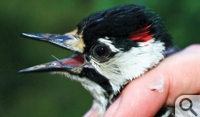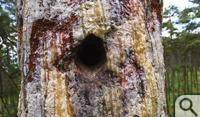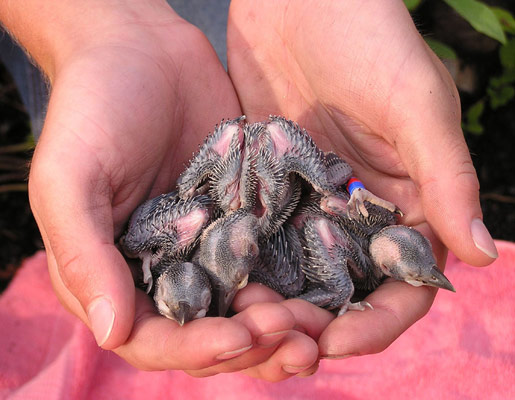The chicks go wild
A bit of a baby boom for a rare woodpecker species
Virginia’s breeding population of red-cockaded woodpeckers reached a new high this year, with nine breeding pairs documented in late May.
The population reached an all-time low in 2002—only two breeding pairs. However, due to the work of a group of preservationists including Bryan D. Watts and the Center for Conservation Biology, this endangered species is starting to make a comeback in Virginia.
During the 2011 breeding season, CCB scientists not only recorded the highest number of breeding pairs in 3 decades, but they also banded 26 chicks. That’s the good news. The bad news is that Virginia’s recovering population is beginning to outgrow its limited habitat.
 Watts, the director
of the CCB, takes his team out to The Nature Conservancy’s Piney Grove Preserve
each spring to record a variety of information about the population. They
record the number of eggs in each cluster, or group, of birds. These birds are
cooperative breeders, so a cluster may contain a “helper” bird, as well as the
breeding pair.
Watts, the director
of the CCB, takes his team out to The Nature Conservancy’s Piney Grove Preserve
each spring to record a variety of information about the population. They
record the number of eggs in each cluster, or group, of birds. These birds are
cooperative breeders, so a cluster may contain a “helper” bird, as well as the
breeding pair.
When the eggs hatch, they record the number of chicks per cluster. In May, the team recorded 26 chicks among the nine breeding pairs of woodpeckers. Five to ten days after hatching, Watts and his team place bands on the chick’s legs.
“They receive three color bands on one leg, and a color band and a U.S. Fish and Wildlife Service band on the other leg,” Watts explained, adding that the pattern of the color bands is unique to each chick. “The reason for doing that is so we know individual birds when we see them again.”
The team will head back out to the preserve when the woodpeckers reach their fledgling state. According to Mike Wilson, a senior biologist at the CCB, the birds fledge when they leave the nest tree and begin to roost in their own tree cavity. The CCB researchers will record the number of males and females, using the red “cockade,” or crown patch, of the fledgling males to distinguish the sexes, and the colored leg bands to distinguish individuals.
Facing saturation
The Piney Woods group constitutes the only red-cockaded woodpeckers breeding in Virginia. The recovering population is nearly outgrowing the nesting habitat, presenting the CCB with another problem.
“What will happen is that we’ll reach saturation of that patch, and so all the available areas will be consumed,” Watts said. “There’s no prospect for further population growth until other patches come of age, and so we’re looking at probably a forty-year lag.”
 He explained that
red-cockaded woodpeckers are extremely particular about their nesting trees,
and the destruction of suitable habitat is the main reason for the species’
decline. The Piney Woods patch is the only one in Virginia with pine trees at
least 80 to 100 years old, representing a limited space for the woodpeckers to
build cavities and breed. Some of the birds may try to breed in other places
across Virginia, Wilson said, but CCB research indicates migration is likely to
prove unsuccessful for the woodpeckers: There are just no other suitable
locations.
He explained that
red-cockaded woodpeckers are extremely particular about their nesting trees,
and the destruction of suitable habitat is the main reason for the species’
decline. The Piney Woods patch is the only one in Virginia with pine trees at
least 80 to 100 years old, representing a limited space for the woodpeckers to
build cavities and breed. Some of the birds may try to breed in other places
across Virginia, Wilson said, but CCB research indicates migration is likely to
prove unsuccessful for the woodpeckers: There are just no other suitable
locations.
To combat the shrinking habitat, the team has taken a variety of measures to help the woodpeckers. One involves giving the woodpeckers artificial cavities: a special bird box that is plastered over and painted to look as though it is a part of the tree. Watts said, however, that the woodpeckers abandon certain cavities after a period of time, for reasons that the team has yet to understand.
Long-term measures still being worked out. Efforts have been put into place to plant other pine trees in Virginia for the birds, but there is no way to speed up the aging of the pine trees. So during this 40-year lag, Watts and his team will continue to monitor and manage the woodpecker population in a holding pattern.
Working together
The Center for Conservation Biology has been working with the red-cockaded woodpeckers in conjunction with the Nature Conservancy and the U.S. Fish and Wildlife Service since the 1970s, when the Endangered Species Act was passed and the woodpeckers were placed on the list. Efforts started by Mitchell A. Byrd, former Chancellor Professor of Biology and co-founder of CCB, and Dana Bradshaw, also of the CCB, have continued for the past 30 years to maintain a population of the species in Virginia.
The CCB is a joint
program supported by the College of William and Mary and Virginia Commonwealth
University.![]()
















